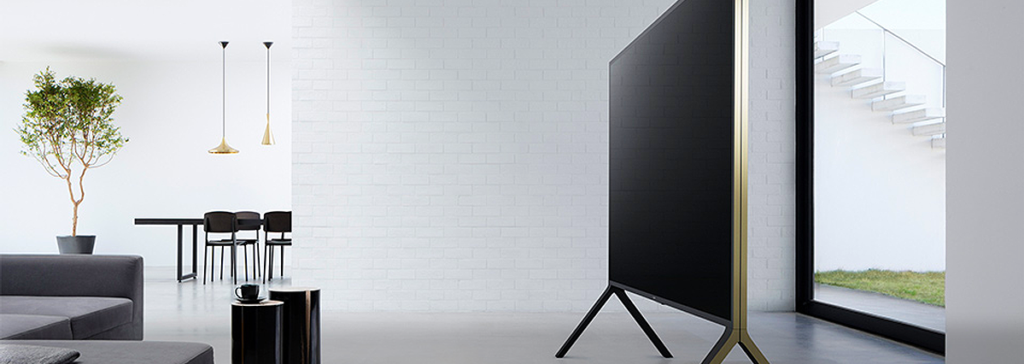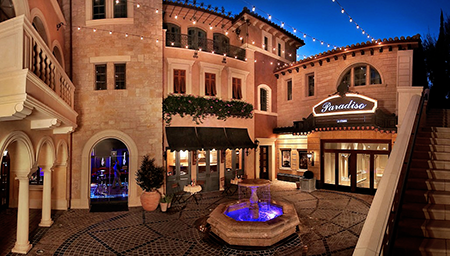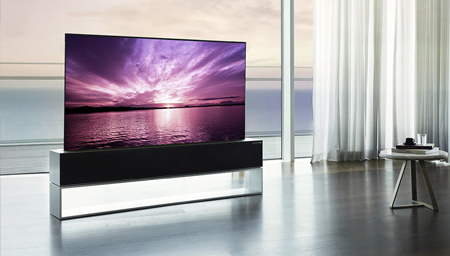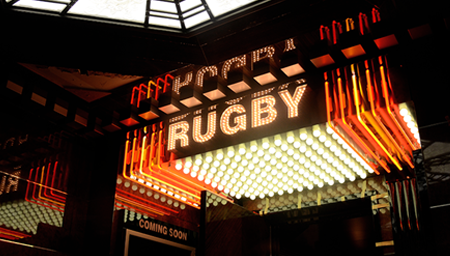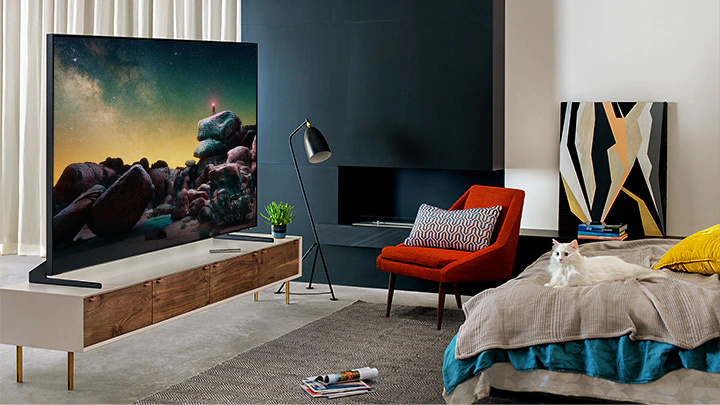also on Cineluxe
Sign up for our monthly newsletter to stay up to date on Cineluxe
Coming close on the heels of Samsung’s 98-inch display, Sony ups the big-screen ante by two inches more
by John Sciacca
December 6, 2021
One of the biggest announcements to come from Sony Electronics this year was the introduction of a new class of TV: the Bravia XR100X92. For those in the know deciphering Sony’s model numbering, you’ll pick up that the 100 refers to the screen size, with this the company’s first residential foray into a 100-inch direct-view LED TV. Along with this Sony, Samsung also launched its own near-100-inch display, the 98-inch QN98QN90 (shown at right).
Both sets boast all the latest technology must-haves, including 4K HDR with Dolby Vision, HDMI 2.1 with support for 4K at 120 frames per second for next-generation gaming, premium video processing for the best image quality, and HDMI eARC for Dolby Atmos support, and offer the ability to have a cinema-sized display in any lighting environment. We’ve seen size-creep happening over the past few years—with 65-inch TVs quickly being replaced by 75- and 85-inch models in larger, shared-viewing spaces—and these larger screens are the natural evolution.
We’ve certainly enjoyed large displays in the past, particularly with the size wars around 2008 when Panasonic did the ultimate one-up on everyone by displaying a 150-inch plasma screen at CES. I remember seeing it in person and feeling the wave of heat that poured off the screen as you stood near it—its power demands would make you customer-of-the-month with your electric company.
But, beyond the quantum leaps in technology improvements 13 years have brought, these sets are now very real, run off a standard power circuit, and are offered at pricing that makes them attractive for a variety of applications. Considering Samsung debuted a different 98-inch model just two years ago at $100,000, these displays represent a massive shift, with the Sony retailing for $20,000 and the Samsung for $15,000. At that pricing, it will open quite a few options for going with larger screen sizes in more areas, such as a primary display in a open-floorplan media room or second home.
One of the big advantages direct-view LED displays have over front projectors—the traditional technology used for larger sizes—is their ability to work in open spaces and in rooms that get a lot of natural light. To deliver its best image quality, a projector requires a near-black viewing environment or use with special ambient-light-rejecting screens. In the past, people living in townhomes or beachfront would have to either commit to a lot of window treatments in order to get a room dark enough for a projection system to be viable or wait until sundown to watch. But these sets have plenty of light output, and can deliver reference-quality black levels in any lighting condition, allowing them to be used in locations without any shading. They are also great for play/game rooms where you want to watch/game with the lights up and still enjoy a no-compromise, immersive image.
For absolute image quality, direct-view displays like these also have a real advantage on brightness, contrast, and HDR presentation. With the flagship video processing and multi-zone local dimming available on both the Samsung and Sony, black levels can plumb deeper, and bright whites have more pop, delivering far more contrast than a projector is capable of. Further, they have the advantage of Dolby Vision compatibility, a dynamic HDR version that is becoming the choice for streaming services like Disney+ and Netflix but is still not supported by any home projector manufacturer due to light-output limitations. Also, there is no concern over having to pair it with the correct screen material, ensuring you get the best picture quality straight out of the box.
Another great benefit is they don’t require any other components to work. Whereas a projector is just a display, requiring a screen, audio system, and source components to function, these sets require just power and Wi-Fi to be fully up and running. While any serious viewing will certainly benefit from adding a separate audio system—and with the myriad of options available, concealing or integrating a full surround speaker system is within the reach of any designer or integrator—the larger screen and cabinet size enables using larger, more full-range speakers to provide audio that is a step up from smaller sets. And with a host of built-in apps, you can stream true 4K HDR content from the likes of Netflix, Disney+, Amazon Prime, and Vudu. Both sets also offer voice-control support from Google Assistant and Amazon Alexa, giving a simple, hands-free control option. For owners looking to have a statement-piece video display in a second home or larger bedroom but don’t want the complexity of adding other components with it, these displays make an attractive option.
Of course, concealing a 100-inch screen when not in use can be a challenge, and having a massive “black hole” in your space can impose design concerns. With a motorized projection screen, you can just roll it into a concealed case up in the ceiling and have it completely out of site when off, which is certainly more of an issue with a panel measuring 89 inches wide by 51 inches tall and weighing just under 200 pounds. While both Sony and Samsung offer ambient modes to display curated photos or artwork when not in use, these sets can also expand the use of digital-canvas applications, where artwork can be commissioned for display when the set is off, turning the large screen from an eyesore into a centerpiece. While both sets can be safely mounted on standard 2×4 wall construction, higher-end automation manufacturers like Future Automation and Nexus 21 offer a variety of creative—and custom—pop-up and drop-down lifts that can conceal the set away until it’s showtime, an option your designer or integrator could discuss to find the best way to incorporate.
At these sizes and prices, these sets will certainly start the conversation about what is possible in different areas of the home, as well as how the design should look and what kind of sound system option will make the best pairing. But they definitely beg the question: Will they replace front projection systems in dedicated movie spaces? And that is something I’ll answer in an upcoming post.
Probably the most experienced writer on custom installation in the industry, John Sciacca is co-owner of Custom Theater & Audio in Murrells Inlet, South Carolina, & is known for his writing for such publications as Residential Systems and Sound & Vision. Follow him on Twitter at @SciaccaTweets and at johnsciacca.com.
© 2023 Cineluxe LLC

